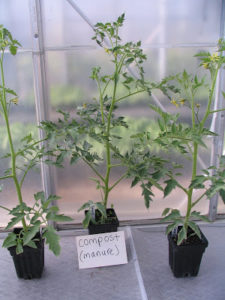Five Weeks After Planting Tomatoes in Manure Compost-Damage Evident
go.ncsu.edu/readext?466701
en Español / em Português
El inglés es el idioma de control de esta página. En la medida en que haya algún conflicto entre la traducción al inglés y la traducción, el inglés prevalece.
Al hacer clic en el enlace de traducción se activa un servicio de traducción gratuito para convertir la página al español. Al igual que con cualquier traducción por Internet, la conversión no es sensible al contexto y puede que no traduzca el texto en su significado original. NC State Extension no garantiza la exactitud del texto traducido. Por favor, tenga en cuenta que algunas aplicaciones y/o servicios pueden no funcionar como se espera cuando se traducen.
Português
Inglês é o idioma de controle desta página. Na medida que haja algum conflito entre o texto original em Inglês e a tradução, o Inglês prevalece.
Ao clicar no link de tradução, um serviço gratuito de tradução será ativado para converter a página para o Português. Como em qualquer tradução pela internet, a conversão não é sensivel ao contexto e pode não ocorrer a tradução para o significado orginal. O serviço de Extensão da Carolina do Norte (NC State Extension) não garante a exatidão do texto traduzido. Por favor, observe que algumas funções ou serviços podem não funcionar como esperado após a tradução.
English
English is the controlling language of this page. To the extent there is any conflict between the English text and the translation, English controls.
Clicking on the translation link activates a free translation service to convert the page to Spanish. As with any Internet translation, the conversion is not context-sensitive and may not translate the text to its original meaning. NC State Extension does not guarantee the accuracy of the translated text. Please note that some applications and/or services may not function as expected when translated.
Collapse ▲9/6/2022 – I wrote this post twelve years ago and it is as relevant now as it was then…unfortunately. Here is our recently updated bulletin, too. AND BE SURE TO INVESTIGATE OTHER REASONS FOR PLANT GROWTH PROBLEMS AFTER APPLYING MANURE OR COMPOST, MOST NOTABLY, HIGH SALTS. CONTACT YOUR COUNTY EXTENSION AGENT FOR ADVICE.
7/26/2010 – Some home gardeners in Asheville suspected plant damage from some composted manure they had purchased. They wondered if it could be from herbicide carryover on hay that the animals who produced the manure had eaten. The producer of the compost was puzzled because she was very careful when she purchased hay, asking whether herbicides were used, and she had performed her own bioassays and everything seemed fine. The home gardeners were adamant, however, that the only plants showing the damage were the ones growing in the compost. So, the compost provider brought us large samples of the manure and hay. We took tiny tomato plants and planted them in the manure and with the hay. You can see pictures of those plants at time of planting and three weeks later at:
http://ncalternativecropsandorganics.blogspot.com/2010/07/results-of-bioassays-performed-on.html
Someone left a comment on that blog post saying we should grow the plants longer. They didn’t see damage on their own plants until much later. One of the home gardeners I was doing this study for said the same thing. He said to wait five weeks. So we waited.
Five weeks have passed. This morning, my technician, Amy Hamilton, checked on the plants and took these pictures. As you can clearly see, the plants growing with the composted manure are now exhibiting unusual growth. I asked the pathology technician in our building, who has examined thousands of tomato plants in her career, to take a look at them and without hesitation she said “herbicide damage”. I will have our pathologist and weed scientist also take a look at these plants because I am not qualified to make a definite diagnosis myself. But clearly, something is not right with these plants.
I am puzzled about why it took this long for damage to develop. We planted very tiny transplants into the mix of composted manure and potting media and they grew fine for a long time. But this also brings into question, at least to me, the bioassay procedures that we and others have in our publications on this topic. We don’t tell people to grow their test plants that long! I will keep you posted as we learn more.
You can also see the results after seven weeks.
Reviewed by Jeanine Davis, NC Alternative Crops and Organics Program, Department of Horticultural Science, NC State University on 9/6/2022.






